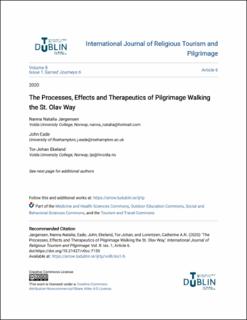| dc.contributor.author | Jørgensen, Nanna Natalia Karpinska Dam | |
| dc.contributor.author | Eade, John | |
| dc.contributor.author | Ekeland, Tor Johan | |
| dc.contributor.author | Lorentzen, Catherine Anne Nicole | |
| dc.date.accessioned | 2021-03-17T13:44:38Z | |
| dc.date.available | 2021-03-17T13:44:38Z | |
| dc.date.created | 2020-02-13T20:37:14Z | |
| dc.date.issued | 2020 | |
| dc.identifier.citation | Jørgensen, N. N., Eade, J., Ekeland, T. J., & Lorentzen, C. (2020). The Processes, Effects and Therapeutics of Pilgrimage Walking the St. Olav Way. The international journal of religious tourism and pilgrimage, 8(1). | en_US |
| dc.identifier.issn | 2009-7379 | |
| dc.identifier.uri | https://hdl.handle.net/11250/2733968 | |
| dc.description.abstract | Pilgrimage walking is increasingly sought as self-therapy for different mental, physical and spiritual ailments, sudden life changes, crossroads or challenges. However, pilgrimage walking as therapy is largely an unexplored ground within health science / care / interventions notwithstanding millennia of human experience. To unfold the nature and add to the knowledge about pilgrimage walking as therapy, this article explores the health-related processes (as experienced mentally, physically, spiritually, socially and in nature), the after-effects (on daily life, behaviour and future actions) and the therapeutic mechanisms (that bring forth these processes and effects) involved in walking the St. Olav Way across Norway. Qualitative open-ended questionnaires were made available at all pilgrim accommodations along the St. Olav route in 2017. In total, 53 pilgrims with an average age of 52 years from 13 nationalities holding different belief systems responded. Process, effect and therapeutic categories were generated through an inductive thematic text analysis of their answers. The findings indicate that pilgrims experience mostly mental health-related processes. People report after-effects involving improved mental, physical, spiritual and social health, personal health assets, and a more positive outlook on life. The stated therapeutics categories came down to three key mechanisms: walking, nature and community. Given the relational and dynamic nature of the results, findings are drawn on relational ontology and the mobility turn. The study encourages further debate around pilgrimage walking’s health qualities in a health context with the hope of arriving at universal therapeutic mechanisms of pilgrimage walking as to acknowledge pilgrimage walking as therapy in the future. | en_US |
| dc.language.iso | eng | en_US |
| dc.relation.uri | https://arrow.tudublin.ie/cgi/viewcontent.cgi?article=1388&context=ijrtp | |
| dc.rights | Navngivelse-Ikkekommersiell-DelPåSammeVilkår 4.0 Internasjonal | * |
| dc.rights.uri | http://creativecommons.org/licenses/by-nc-sa/4.0/deed.no | * |
| dc.title | The Processes, Effects and Therapeutics of Pilgrimage Walking the St. Olav Way | en_US |
| dc.type | Peer reviewed | en_US |
| dc.type | Journal article | en_US |
| dc.description.version | publishedVersion | en_US |
| dc.rights.holder | © International Journal of Religious Tourism and Pilgrimage. | en_US |
| dc.source.pagenumber | 33-50 | en_US |
| dc.source.volume | 8 | en_US |
| dc.source.journal | International Journal of Religious Tourism and Pilgrimage | en_US |
| dc.source.issue | 1 | en_US |
| dc.identifier.doi | https://doi.org/10.21427/v0cc-7135 | |
| dc.identifier.cristin | 1794042 | |
| cristin.ispublished | true | |
| cristin.fulltext | original | |
| cristin.qualitycode | 1 | |

